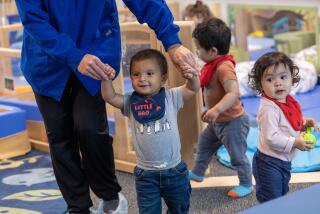Benefits of preschool come with every dollar
AS CALIFORNIA voters consider whether to vote for Proposition 82 -- the ballot measure that would fund preschool for 4-year-olds in the state -- attention has focused on a Rand Corp. report we wrote last year documenting the value of preschool education.
Our study concluded that making a high-quality preschool program available to every 4-year-old would generate an estimated $2 to $4 in benefits to California society for every $1 spent. And the cost of such a universal preschool program is more than outweighed by the benefits -- even using very conservative assumptions.
We did not study the specifics of Proposition 82 or the proposed tax on the wealthiest Californians to fund the measure. And, as a nonprofit, nonpartisan organization that conducts research and analysis, Rand does not take positions on ballot initiatives.
But by examining high-quality preschool programs elsewhere, we were able to conclude that children who attend preschool are likely to do better in school and go on to graduate high school, are less likely to be convicted of crimes and are more likely to earn higher salaries as adults. All this saves governments money and boosts tax revenues. The families of children attending preschool benefit from lower child-care costs. And Californians also gain from lower crime rates.
Critics have questioned how we can be so sure that preschool generates $2 to $4 in societal benefits for every $1 spent. In an ideal world, we would have looked to other states or cities to evaluate the short-term and longer-term effects of their universal preschool programs. Unfortunately, no such studies are available.
What is available is a rigorous body of research that has demonstrated short- and long-term benefits for at-risk children who attended high-quality preschool programs for one or two years before kindergarten. One such public program, the Chicago Child-Parent Centers, serves primarily minority children in low-income neighborhoods; it followed youths from preschool until age 20.
Critics say the Chicago results don’t tell us what would happen in California because the Chicago program differs from what is proposed under Proposition 82 and served a different mix of children. It’s true that the ongoing Chicago program includes both preschool and additional support for at-risk children in grades K-3. But we were careful to count only the measured benefits from the half-day preschool component. And while the Chicago program served only poor children, we adjusted our calculations to account for the presence of children from all income levels who would be served by a universal program.
WE FOUND that if only the poorest 25% of children in California benefited from a year of preschool -- meaning there was no benefit to the other 75% -- Californians could still expect to gain nearly $2 for every $1 invested.
In fact, children from working-class families and middle-class children face many of the same problems as children in poverty. Half of all children who repeat a grade in school, and half of all high school dropouts, come from families in the middle 60% of the income ladder. Any benefits of preschool realized by children from these families push the return from investing in preschool even higher -- from $2.62 to $4 depending on the assumptions of preschool benefits.
Our estimate of $2 to $4 in benefits in California is conservative because we do not count savings that would result from such favorable effects of universal preschool as lower lifetime welfare use and improved lifetime health. Although critics are right that some studies find that early gains in achievement scores eventually fade, other benefits have been measured at older ages, including better high school graduation rates, less delinquency and crime and higher adult earnings. Based on this evidence, James Heckman, a Nobel Prize-winning economist, has concluded that the United States under-invests in preschool programs for disadvantaged children.
Research in Oklahoma and elsewhere has shown that benefits of universal preschool in the early grades are greatest for the most disadvantaged children. We believe this would be the case in California as well. So there are trade-offs between using public funds to pay for a universal preschool program versus providing free preschool only for at-risk children.
Targeted programs providing free preschool only for low-income children would cost less and can be expected to generate higher returns per child. On the other hand, paying for preschool for all eliminates the bureaucracy for determining which children are eligible each year (some children would be classified at-risk one year and not the next). It would avoid stigmatizing children in targeted programs. And it would make sure preschool is available to all children who can benefit. Whether those benefits are worth the cost is for voters to decide.
More to Read
Get the L.A. Times Politics newsletter
Deeply reported insights into legislation, politics and policy from Sacramento, Washington and beyond. In your inbox three times per week.
You may occasionally receive promotional content from the Los Angeles Times.










